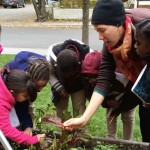
Last week, I was fortunate enough to see GCG’s two garden education specialists in action. On an early Wednesday morning, Adrienne and Leilani (who let me tag along) made the drive up to Beverly, MA for their weekly garden education program.
At Beverly, there are three classes of third graders, and they each get their own lesson focused on the garden. On this day, the students started with what would be the final harvest of the season, picking carrots, kale, lettuce, eggplant, chard, cabbage, pea greens, eggplants and pulling out all the plants that were no longer going to produce. It was exciting to see how much the kids enjoyed it, each asking if they could pick more from the garden – “can we please pick the cabbages” one student kept pleading. But we had to be careful to make sure the first classes didn’t get too enthusiastic with their harvest or there would be nothing left for the others to pick.
After the students harvested the vegetables, putting each different type into separate bags to be later used in their school lunches, it was time for their weekly lesson. This week the focus was on compost. Adrienne and Leilani had prepared a class on how to create and maintain a successful compost pile, with Adrienne even bringing in her new worm compost box. They started out by teaching the students which elements compost needed to be successful, such as the correct ratio of plant material to paper products to maintain the correct moisture content. Then they went over what could go into the compost bin, and what could not go in. Meat and cheese were out, while vegetable scrapes and plant material were a definite yes.
After the compost lesson, students were invited to feel the soil in two different buckets. One bucket contained soil created from leaf compost, while the other was soil that had been created with worms. They told us they could really feel the difference, and then revealed to us solid proof of their disparity: the worm soil was sticky enough to make ‘dirt balls’, which the students were extremely happy to demonstrate, while the soil composted with leaves unfortunately could not. Next, if they wanted, the students could go and check out Adrienne’s worm compost box, with the option to get right in and touch them to see the worms in action.
As the students lined up and began their walk back to their classrooms, all the while waving goodbye to Adrienne and Leilani, I thought about how important these lessons are for these children. Not only were they being educated about their food and about the essentials of farming, they were able to have a direct connection to the food that many would later eat in the cafeteria. They were able to experience were food comes from, and that they themselves had the power to grow this fresh and healthy food. They will grow up knowing where food comes from, and will hopefully take these lessons to support and consume local, fresh, healthy food that is both good for them, and for the planet. Maybe they will even put in their own garden one day, how about you?
By - Hannah Kitchel


